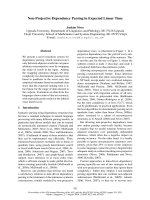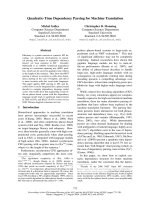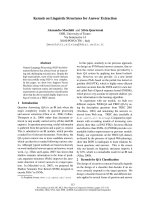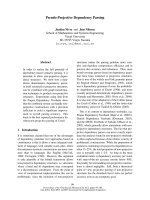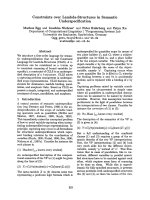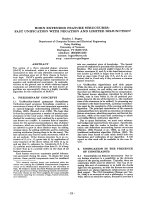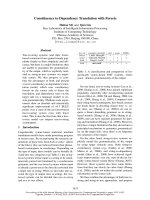Báo cáo khoa học: "Building Deep Dependency Structures with a Wide-Coverage CCG Parser" ppt
Bạn đang xem bản rút gọn của tài liệu. Xem và tải ngay bản đầy đủ của tài liệu tại đây (75.67 KB, 8 trang )
Building Deep Dependency Structures with a Wide-Coverage CCG Parser
Stephen Clark, Julia Hockenmaier and Mark Steedman
Division of Informatics
University of Edinburgh
Edinburgh EH8 9LW, UK
stephenc, julia, steedman @cogsci.ed.ac.uk
Abstract
This paper describes a wide-coverage sta-
tistical parser that uses Combinatory Cat-
egorial Grammar (CCG) to derive de-
pendency structures. The parser differs
from most existing wide-coverage tree-
bank parsers in capturing the long-range
dependencies inherent in constructions
such as coordination, extraction, raising
and control, as well as the standard local
predicate-argument dependencies. A set
of dependency structures used for train-
ing and testing the parser is obtained from
a treebank of CCG normal-form deriva-
tions, which have been derived (semi-) au-
tomatically from the Penn Treebank. The
parser correctly recovers over 80% of la-
belled dependencies, and around 90% of
unlabelled dependencies.
1 Introduction
Most recent wide-coverage statistical parsers have
used models based on lexical dependencies (e.g.
Collins (1999), Charniak (2000)). However, the de-
pendencies are typically derived from a context-free
phrase structure tree using simple head percolation
heuristics. This approach does not work well for the
long-range dependencies involved in raising, con-
trol, extraction and coordination, all of which are
common in text such as the Wall Street Journal.
Chiang (2000) uses Tree Adjoining Grammar
as an alternative to context-free grammar, and
here we use another “mildly context-sensitive” for-
malism, Combinatory Categorial Grammar (CCG,
Steedman (2000)), which arguably provides the
most linguistically satisfactory account of the de-
pendencies inherent in coordinate constructions and
extraction phenomena. The potential advantage
from using such an expressive grammar is to facili-
tate recovery of such unbounded dependencies. As
well as having a potential impact on the accuracy of
the parser, recovering such dependencies may make
the output more useful.
CCG is unlike other formalisms in that the stan-
dard predicate-argument relations relevant to inter-
pretation can be derived via extremely non-standard
surface derivations. This impacts on how best to de-
fine a probability model for CCG, since the “spuri-
ous ambiguity” of CCG derivations may lead to an
exponential number of derivations for a given con-
stituent. In addition, some of the spurious deriva-
tions may not be present in the training data. One
solution is to consider only the normal-form (Eis-
ner, 1996a) derivation, which is the route taken in
Hockenmaier and Steedman (2002b).
1
Another problem with the non-standard surface
derivations is that the standard PARSEVAL per-
formance measures over such derivations are unin-
formative (Clark and Hockenmaier, 2002). Such
measures have been criticised by Lin (1995) and
Carroll et al. (1998), who propose recovery of head-
dependencies characterising predicate-argument re-
lations as a more meaningful measure.
If the end-result of parsing is interpretable
predicate-argument structure or the related depen-
dency structure, then the question arises: why build
derivation structure at all? A CCG parser can
directly build derived structures, including long-
1
Another, more speculative, possibility is to treat the alter-
native derivations as hidden and apply the EM algorithm.
Computational Linguistics (ACL), Philadelphia, July 2002, pp. 327-334.
Proceedings of the 40th Annual Meeting of the Association for
range dependencies. These derived structures can
be of any form we like—for example, they could
in principle be standard Penn Treebank structures.
Since we are interested in dependency-based parser
evaluation, our parser currently builds dependency
structures. Furthermore, since we want to model
the dependencies in such structures, the probability
model is defined over these structures rather than the
derivation.
The training and testing material for this CCG
parser is a treebank of dependency structures, which
have been derived from a set of CCG deriva-
tions developed for use with another (normal-form)
CCG parser (Hockenmaier and Steedman, 2002b).
The treebank of derivations, which we call CCG-
bank (Hockenmaier and Steedman, 2002a), was in
turn derived (semi-)automatically from the hand-
annotated Penn Treebank.
2 The Grammar
In CCG, most language-specific aspects of the gram-
mar are specified in the lexicon, in the form of syn-
tactic categories that identify a lexical item as either
a functor or argument. For the functors, the category
specifies the type and directionality of the arguments
and the type of the result. For example, the follow-
ing category for the transitive verb bought specifies
its first argument as a noun phrase (NP) to its right
and its second argument as an NP to its left, and its
result as a sentence:
(1) bought :=
S NP NP
For parsing purposes, we extend CCG categories
to express category features, and head-word and de-
pendency information directly, as follows:
(2) bought := S dcl
bought
NP
1
NP
2
The feature dcl specifies the category’s S result as a
declarative sentence, bought identifies its head, and
the numbers denote dependency relations. Heads
and dependencies are always marked up on atomic
categories (S, N, NP, PP, and conj in our implemen-
tation).
The categories are combined using a small set of
typed combinatory rules, such as functional applica-
tion and composition (see Steedman (2000) for de-
tails). Derivations are written as follows, with under-
lines indicating combinatory reduction and arrows
indicating the direction of the application:
(3) Marks bought Brooks
NP
Marks
S dcl
bought
NP
1
NP
2
NP
Brooks
S dcl
bought
NP
1
S dcl
bought
Formally, a dependency is defined as a 4-tuple:
h
f
f s h
a
, where h
f
is the head word of the func-
tor,
2
f is the functor category (extended with head
and dependency information), s is the argument slot,
and h
a
is the head word of the argument—for exam-
ple, the following is the object dependency yielded
by the first step of derivation (3):
(4) bought S dcl
bought
NP
1
NP
2
2 Brooks
Variables can also be used to denote heads, and
used via unification to pass head information from
one category to another. For example, the expanded
category for the control verb persuade is as follows:
(5) persuade := S dcl
persuade
NP
1
S to
2
NP
X
NP
X,3
The head of the infinitival complement’s subject is
identified with the head of the object, using the vari-
able X. Unification then “passes” the head of the ob-
ject to the subject of the infinitival, as in standard
unification-based accounts of control.
3
The kinds of lexical items that use the head pass-
ing mechanism are raising, auxiliary and control
verbs, modifiers, and relative pronouns. Among the
constructions that project unbounded dependencies
are relativisation and right node raising. The follow-
ing category for the relative pronoun category (for
words such as who, which, that) shows how heads
are co-indexed for object-extraction:
(6) who :=
NP
X
NP
X,1
S dcl
2
NP
X
The derivation for the phrase The company that
Marks wants to buy is given in Figure 1 (with the
features on S categories removed to save space, and
the constant heads reduced to the first letter). Type-
raising ( ) and functional composition ( ), along
2
Note that the functor does not always correspond to the lin-
guistic notion of a head.
3
The extension of CCG categories in the lexicon and the la-
belled data is simplified in the current system to make it entirely
automatic. For example, any word with the same category (5)
as persuade gets the object-control extension. In certain rare
cases (such as promise) this gives semantically incorrect depen-
dencies in both the grammar and the data (promise Brooks to go
has a structure meaning promise Brooks that Brooks will go).
The company that Marks wants to buy
NP
x
N
x,1
N
c
NP
x
NP
x,1
S
2
NP
x
NP
m
S
w
NP
x,1
S
2
NP
x
S
y
NP
x,1
S
y,2
NP
x
S
b
NP
1
NP
2
NP
c
S
x
S
x
NP
m
S
b
NP NP
S
w
NP NP
S
w
NP
NP
x
NP
x
NP
c
Figure 1: Relative clause derivation
with co-indexing of heads, mediate transmission of
the head of the NP the company onto the object of
buy. The corresponding dependencies are given in
the following figure, with the convention that arcs
point away from arguments. The relevant argument
slot in the functor category labels the arcs.
1
2
2 2
2
1
1
1 1
The towantscompany Marksthat buy
Note that we encode the subject argument of the
to category as a dependency relation (Marks is a
“subject” of to), since our philosophy at this stage
is to encode every argument as a dependency, where
possible. The number of dependency types may be
reduced in future work.
3 The Probability Model
The DAG-like nature of the dependency structures
makes it difficult to apply generative modelling tech-
niques (Abney, 1997; Johnson et al., 1999), so
we have defined a conditional model, similar to
the model of Collins (1996) (see also the condi-
tional model in Eisner (1996b)). While the model
of Collins (1996) is technically unsound (Collins,
1999), our aim at this stage is to demonstrate that
accurate, efficient wide-coverage parsing is possible
with CCG, even with an over-simplified statistical
model. Future work will look at alternative models.
4
4
The reentrancies creating the DAG-like structures are fairly
limited, and moreover determined by the lexical categories. We
conjecture that it is possible to define a generative model that
includes the deep dependencies.
The parse selection component must choose the
most probable dependency structure, given the sen-
tence S. A sentence S
w
1
t
1
w
2
t
2
w
n
t
n
is assumed to be a sequence of word, pos-tag
pairs. For our purposes, a dependency structure π
is a C D pair, where C c
1
c
2
c
n
is the se-
quence of categories assigned to the words, and
D
h
f
i
f
i
s
i
h
a
i
i 1 m is the set of de-
pendencies. The probability of a dependency struc-
ture can be written as follows:
(7) P π P C D S P C S P D C S
The probability P C S can be approximated as
follows:
(8) P
C S
∏
n
i
1
P
c
i
X
i
where X
i
is the local context for the ith word. We
have explained elsewhere (Clark, 2002) how suit-
able features can be defined in terms of the word,
pos-tag pairs in the context, and how maximum en-
tropy techniques can be used to estimate the proba-
bilities, following Ratnaparkhi (1996).
We assume that each argument slot in the cat-
egory sequence is filled independently, and write
P D C S as follows:
(9) P D C S
∏
m
i
1
P h
a
i
C S
where h
a
i
is the head word filling the argument slot
of the ith dependency, and m is the number of de-
pendencies entailed by the category sequence C.
3.1 Estimating the dependency probabilities
The estimation method is based on Collins (1996).
We assume that the probability of a dependency only
depends on those words involved in the dependency,
together with their categories. We follow Collins
and base the estimate of a dependency probability
on the following intuition: given a pair of words,
with a pair of categories, which are in the same sen-
tence, what is the probability that the words are in a
particular dependency relationship?
We again follow Collins in defining the following
functions, where is the set of words in the data,
and
is the set of lexical categories.
C a b c d for a c and b d is the number
of times that word-category pairs
a b and c d are in
the same word-category sequence in the training data.
C R a b c d is the number of times that a b and
c d are in the same word-category sequence, with a and
c in dependency relation R.
F R a b c d is the probability that a and c are in de-
pendency relation R, given that
a b and c d are in the
same word-category sequence.
The relative frequency estimate of the probability
F
R a b c d is as follows:
(10)
ˆ
F R a b c d
C R a b c d
C a b c d
The probability P h
a
i
C S can now be approxi-
mated as follows:
(11) P h
a
i
C S
ˆ
F
R h
f
i
f
i
h
a
i
c
a
i
∑
n
j
1
ˆ
F
R h
f
i
f
i
w
j
c
j
where c
a
i
is the lexical category of the argument
head a
i
. The normalising factor ensures that the
probabilities for each argument slot sum to one over
all the word-category pairs in the sequence.
5
This
factor is constant for the given category sequence,
but not for different category sequences. However,
the dependency structures with high enough P
C S
to be among the highest probability structures are
likely to have similar category sequences. Thus we
ignore the normalisation factor, thereby simplifying
the parsing process. (A similar argument is used by
Collins (1996) in the context of his parsing model.)
The estimate in equation 10 suffers from sparse
data problems, and so a backing-off strategy is em-
ployed. We omit details here, but there are four lev-
els of back-off: the first uses both words and both
categories; the second uses only one of the words
and both categories; the third uses the categories
only; and a final level substitutes pos-tags for the
categories.
One final point is that, in practice, the number of
dependencies can vary for a given category sequence
(because multiple arguments for the same slot can
5
One of theproblems with the model is that it isdeficient, as-
signing probability mass to dependency structures not licensed
by the grammar.
be introduced through coordination), and so a geo-
metric mean of p
π is used as the ranking function,
averaged by the number of dependencies in D.
4 The Parser
The parser analyses a sentence in two stages. First,
in order to limit the number of categories assigned
to each word in the sentence, a “supertagger” (Ban-
galore and Joshi, 1999) assigns to each word a small
number of possible lexical categories. The supertag-
ger (described in Clark (2002)) assigns to each word
all categories whose probabilities are within some
constant factor, β, of the highest probability cate-
gory for that word, given the surrounding context.
Note that the supertagger does not provide a single
category sequence for each sentence, and the final
sequence returned by the parser (along with the de-
pendencies) is determined by the probability model
described in the previous section. The supertagger is
performing two roles: cutting down the search space
explored by the parser, and providing the category-
sequence model in equation 8.
The supertagger consults a “category dictionary”
which contains, for each word, the set of categories
the word was seen with in the data. If a word ap-
pears at least K times in the data, the supertagger
only considers categories that appear in the word’s
category set, rather than all lexical categories.
The second parsing stage applies a CKY
bottom-up chart-parsing algorithm, as described in
Steedman (2000). The combinatory rules currently
used by the parser are as follows: functional ap-
plication (forward and backward), generalised for-
ward composition, backward composition, gener-
alised backward-crossed composition, and type-
raising. There is also a coordination rule which con-
joins categories of the same type.
6
Type-raising is applied to the categories NP, PP,
and S
adj NP (adjectival phrase); it is currently
implemented by simply adding pre-defined sets of
type-raised categories to the chart whenever an NP,
PP or S adj NP is present. The sets were chosen
on the basis of the most frequent type-raising rule
instantiations in sections 02-21 of the CCGbank,
which resulted in 8 type-raised categories for NP,
6
Restrictions are placed on some of the rules, such as that
given by Steedman (2000) for backward-crossed composition
(p.62).
and 2 categories each for PP and S adj NP.
As well as combinatory rules, the parser also uses
a number of lexical rules and rules involving punc-
tuation. The set of rules consists of those occurring
roughly more than 200 times in sections 02-21 of the
CCGbank. For example, one rule used by the parser
is the following:
(12) S
ing NP NP
X
NP
X
This rule creates a nominal modifier from an ing-
form of a verb phrase.
A set of rules allows the parser to deal with com-
mas (all other punctuation is removed after the su-
pertagging phase). For example, one kind of rule
treats a comma as a conjunct, which allows the NP
object in John likes apples, bananas and pears to
have three heads, which can all be direct objects of
like.
7
The search space explored by the parser is re-
duced by exploiting the statistical model. First, a
constituent is only placed in a chart cell if there is
not already a constituent with the same head word,
same category, and some dependency structure with
a higher or equal score (where score is the geomet-
ric mean of the probability of the dependency struc-
ture). This tactic also has the effect of eliminat-
ing “spuriously ambiguous” entries from the chart—
cf. Komagata (1997). Second, a constituent is only
placed in a cell if the score for its dependency struc-
ture is within some factor, α, of the highest scoring
dependency structure for that cell.
5 Experiments
Sections 02-21 of the CCGbank were used for train-
ing (39
161 sentences); section 00 for development
(1 901 sentences); and section 23 for testing (2 379
sentences).
8
Sections 02-21 were also used to obtain
the category set, by including all categories that ap-
pear at least 10 times, which resulted in a set of 398
category types.
The word-category sequences needed for estimat-
ing the probabilities in equation 8 can be read di-
rectly from the CCGbank. To obtain dependencies
7
These rules are currently applied deterministically. In fu-
ture work we will investigate approaches which integrate the
rule applications with the statistical model.
8
A small number of sentences in the Penn
Treebank do not appear in the CCGbank (see
Hockenmaier and Steedman (2002a)).
for estimating P
D C S , we ran the parser over the
trees, tracing out the combinatory rules applied dur-
ing the derivation, and outputting the dependencies.
This method was also applied to the trees in section
23 to provide the gold standard test set.
Not all trees produced dependency structures,
since not all categories and type-changing rules in
the CCGbank are encoded in the parser. We obtained
dependency structures for roughly 95% of the trees
in the data. For evaluation purposes, we increased
the coverage on section 23 to 99
0% (2 352 sen-
tences) by identifying the cause of the parse failures
and adding the additional rules and categories when
creating the gold-standard; so the final test set con-
sisted of gold-standard dependency structures from
2 352 sentences. The coverage was increased to en-
sure the test set was representative of the full section.
We emphasise that these additional rules and cate-
gories were not made available to the parser during
testing, or used for training.
Initially the parser was run with β
0 01 for the
supertagger (an average of 3
8 categories per word),
K
20 for the category dictionary, and α 0 001
for the parser. A time-out was applied so that the
parser was stopped if any sentence took longer than
2 CPU minutes to parse. With these parameters,
2
098 of the 2 352 sentences received some anal-
ysis, with 206 timing out and 48 failing to parse.
To deal with the 48 no-analysis cases, the cut-off
for the category-dictionary, K, was increased to 100.
Of the 48 cases, 23 sentences then received an anal-
ysis. To deal with the 206 time-out cases, β was
increased to 0 05, which resulted in 181 of the 206
sentences then receiving an analysis, with 18 failing
to parse, and 7 timing out. So overall, almost 98% of
the 2
352 unseen sentences were given some analy-
sis.
To return a single dependency structure, we chose
the most probable structure from the S dcl categories
spanning the whole sentence. If there was no such
category, all categories spanning the whole string
were considered.
6 Results
To measure the performance of the parser, we com-
pared the dependencies output by the parser with
those in the gold standard, and computed precision
and recall figures over the dependencies. Recall that
a dependency is defined as a 4-tuple: a head of a
functor, a functor category, an argument slot, and a
head of an argument. Figures were calculated for la-
belled dependencies (LP,LR) and unlabelled depen-
dencies (UP,UR). To obtain a point for a labelled de-
pendency, each element of the 4-tuple must match
exactly. Note that the category set we are using dis-
tinguishes around 400 distinct types; for example,
tensed transitive buy is treated as a distinct category
from infinitival transitive buy. Thus this evaluation
criterion is much more stringent than that for a stan-
dard pos-tag label-set (there are around 50 pos-tags
used in the Penn Treebank).
To obtain a point for an unlabelled dependency,
the heads of the functor and argument must appear
together in some relation (either as functor or argu-
ment) for the relevant sentence in the gold standard.
The results are shown in Table 1, with an additional
column giving the category accuracy.
LP % LR % UP % UR% category %
no ∆ 81 3 82 1 89 1 90 1 90 6
with ∆ 81 9 81 8 90 1 89 9 90 3
Table 1: Overall dependency results for section 23
As an additional experiment, we conditioned the
dependency probabilities in 10 on a “distance mea-
sure” (∆). Distance has been shown to be a use-
ful feature for context-free treebank style parsers
(e.g. Collins (1996), Collins (1999)), although our
hypothesis was that it would be less useful here, be-
cause the CCG grammar provides many of the con-
straints given by ∆, and distance measures are biased
against long-range dependencies.
We tried a number of distance measures, and the
one used here encodes the relative position of the
heads of the argument and functor (left or right),
counts the number of verbs between argument and
functor (up to 1), and counts the number of punctu-
ation marks (up to 2). The results are also given in
Table 1, and show that, as expected, adding distance
gives no improvement overall.
An advantage of the dependency-based evalua-
tion is that results can be given for individual de-
pendency relations. Labelled precision and recall on
Section 00 for the most frequent dependency types
are shown in Table 2 (for the model without distance
measures).
9
The columns # deps give the total num-
ber of dependencies, first the number put forward by
the parser, and second the number in the gold stan-
dard. F-score is calculated as (2*LP*LR)/(LP+LR).
We also give the scores for the dependencies cre-
ated by the subject and object relative pronoun cat-
egories, including the headless object relative pro-
noun category.
We would like to compare these results with those
of other parsers that have presented dependency-
based evaluations. However, the few that exist (Lin,
1995; Carroll et al., 1998; Collins, 1999) have used
either different data or different sets of dependen-
cies (or both). In future work we plan to map our
CCG dependencies onto the set used by Carroll and
Briscoe and parse their evaluation corpus so a direct
comparison can be made.
As far as long-range dependencies are concerned,
it is similarly hard to give a precise evaluation. Note
that the scores in Table 2 currently conflate extracted
and in-situ arguments, so that the scores for the di-
rect objects, for example, include extracted objects.
The scores for the relative pronoun categories give
a good indication of the performance on extraction
cases, although even here it is not possible at present
to determine exactly how well the parser is perform-
ing at recovering extracted arguments.
In an attempt to obtain a more thorough anal-
ysis, we analysed the performance of the parser
on the 24 cases of extracted objects in the gold-
standard Section 00 (development set) that were
passed down the object relative pronoun category
NP
X
NP
X
S dcl NP
X
.
10
Of these, 10 (41.7%)
were recovered correctly by the parser; 10 were in-
correct because the wrong category was assigned to
the relative pronoun, 3 were incorrect because the
relative pronoun was attached to the wrong noun,
and 1 was incorrect because the wrong category was
assigned to the predicate from which the object was
9
Currently all the modifiers in nominal compounds are anal-
ysed in CCGbank as N
N, as a default, since the structure of the
compound is not present in the Penn Treebank. Thus the scores
for N N are not particularly informative. Removing these rela-
tions reduces the overall scores by around 2%. Also, the scores
in Table 2 are for around 95% of the sentences in Section 00, be-
cause of the problem obtaining gold standard dependency struc-
tures for all sentences, noted earlier.
10
The number of extracted objects need not equal the occur-
rences of the category since coordination can introduce more
than one object per category.
Functor Relation LP % # deps LR % # deps F-score
N
X
N
X,1
1 nominal modifier 92 9 6 769 95 1 6 610 94.0
NP
X
N
X,1
1 determiner 95 7 3 804 95 8 3 800 95.7
NP
X
NP
X,1
NP
2
2 np modifying preposition 84 2 2 046 77 3 2 230 80.6
NP
X
NP
X,1
NP
2
1 np modifying preposition 75 8 2 002 74 2 2 045 75.0
S
X
NP
Y
S
X,1
NP
Y
NP
2
2 vp modifying preposition 60 3 1 368 75 8 1 089 67.2
S
X
NP
Y
S
X,1
NP
Y
NP
2
1 vp modifying preposition 54 8 1 263 69 4 997 61.2
S dcl NP
1
NP
2
1 transitive verb 74 8 967 86 4 837 80.2
S dcl NP
1
NP
2
2 transitive verb 77 4 913 83 6 846 80.4
S
X
NP
Y
S
X,1
NP
Y
1 adverbial modifier 77 0 683 75 6 696 76.3
PP NP
1
1 preposition complement 70 9 729 67 2 769 69.0
S b NP
1
NP
2
2 infinitival transitive verb 82 1 608 85 4 584 83.7
S dcl NP
X,1
S b
2
NP
X
2 auxiliary 98 4 447 97 6 451 98.0
S dcl NP
X,1
S b
2
NP
X
1 auxiliary 92 1 455 91 7 457 91.9
S b NP
1
NP
2
1 infinitival transitive verb 79 6 417 78 3 424 78.9
NP
X
N
X,1
NP
2
1 s genitive 93 2 366 94 5 361 93.8
NP
X
N
X,1
NP
2
2 s genitive 91 2 365 94 6 352 92.9
S to
X
NP
Y,1
S b
X,2
NP
Y
1 to-complementiser 85 6 320 81 1 338 83.3
S dcl NP
1
S dcl
2
1 sentential complement verb
87 1 372 90 0 360 88.5
NP
X
NP
X,1
S dcl
2
NP
X
1 subject relative pronoun 73 8 237 69 2 253 71.4
NP
X
NP
X,1
S dcl
2
NP
X
2 subject relative pronoun 95 2 229 86 9 251 90.9
NP
X
NP
X,1
S dcl
2
NP
X
1 object relative pronoun 66 7 15 45 5 22 54.1
NP
X
NP
X,1
S dcl
2
NP
X
2 object relative pronoun 85 7 14 63 2 19 72.8
NP S dcl
1
NP 1 headless object relative pronoun 100 0 10 83 3 12 90.9
Table 2: Results for section 00 by dependency relation
extracted. The tendency for the parser to assign
the wrong category to the relative pronoun in part
reflects the fact that complementiser that is fifteen
times as frequent as object relative pronoun that.
However, the supertagger alone gets 74% of the ob-
ject relative pronouns correct, if it is used to provide
a single category per word, so it seems that our de-
pendency model is further biased against object ex-
tractions, possibly because of the technical unsound-
ness noted earlier.
It should be recalled in judging these figures that
they are only a first attempt at recovering these
long-range dependencies, which most other wide-
coverage parsers make no attempt to recover at all.
To get an idea of just how demanding this task is, it
is worth looking at an example of object relativiza-
tion that the parser gets correct. Figure 2 gives part
of a dependency structure returned by the parser for
a sentence from section 00 (with the relations omit-
ted).
11
Notice that both respect and confidence are
objects of had. The relevant dependency quadruples
found by the parser are the following:
11
The full sentence is The events of April through June dam-
aged the respect and confidence which most Americans previ-
ously had for the leaders of China.
respect and confidence which most Americans previously had
Figure 2: A dependency structure recovered by the
parser from unseen data
(13) which NP
X
NP
X,1
S dcl
2
NP
X
2 had
which NP
X
NP
X,1
S dcl
2
NP
X
1 confidence
which NP
X
NP
X,1
S dcl
2
NP
X
1 respect
had S dcl
had
NP
1
NP
2
2 confidence
had S dcl
had
NP
1
NP
2
2 respect
7 Conclusions and Further Work
This paper has shown that accurate, efficient wide-
coverage parsing is possible with CCG. Along with
Hockenmaier and Steedman (2002b), this is the first
CCG parsing work that we are aware of in which
almost 98% of unseen sentences from the CCGbank
can be parsed.
The parser is able to capture a number of long-
range dependencies that are not dealt with by ex-
isting treebank parsers. Capturing such dependen-
cies is necessary for any parser that aims to sup-
port wide-coverage semantic analysis—say to sup-
port question-answering in any domain in which the
difference between questions like Which company
did Marks sue? and Which company sued Marks?
matters. An advantage of our approach is that the
recovery of long-range dependencies is fully inte-
grated with the grammar and parser, rather than be-
ing relegated to a post-processing phase.
Because of the extreme naivety of the statistical
model, these results represent no more than a first
attempt at combining wide-coverage CCG parsing
with recovery of deep dependencies. However, we
believe that the results are promising.
In future work we will present an evaluation
which teases out the differences in extracted and in-
situ arguments. For the purposes of the statistical
modelling, we are also considering building alterna-
tive structures that include the long-range dependen-
cies, but which can be modelled using better moti-
vated probability models, such as generative mod-
els. This will be important for applying the parser to
tasks such as language modelling, for which the pos-
sibility of incremental processing of CCG appears
particularly attractive.
Acknowledgements
Thanks to Miles Osborne and the ACL-02 refer-
ees for comments. Various parts of the research
were funded by EPSRC grants GR/M96889 and
GR/R02450 and EU (FET) grant MAGICSTER.
References
Steven Abney. 1997. Stochastic attribute-value gram-
mars. Computational Linguistics, 23(4):597–618.
Srinivas Bangalore and Aravind Joshi. 1999. Supertag-
ging: An approach to almost parsing. Computational
Linguistics, 25(2):237–265.
John Carroll, Ted Briscoe, and Antonio Sanfilippo. 1998.
Parser evaluation: a survey and a new proposal. In
Proceedings of the 1st LREC Conference, pages 447–
454, Granada, Spain.
Eugene Charniak. 2000. A maximum-entropy-inspired
parser. In Proceedings of the 1st Meeting of the
NAACL, pages 132–139, Seattle, WA.
David Chiang. 2000. Statistical parsing with an
automatically-extracted Tree Adjoining Grammar. In
Proceedings of the 38th Meeting of the ACL, pages
456–463, Hong Kong.
Stephen Clark and Julia Hockenmaier. 2002. Evaluating
a wide-coverage CCG parser. In Proceedings of the
LREC Beyond PARSEVAL workshop (to appear), Las
Palmas, Spain.
Stephen Clark. 2002. A supertagger for Combinatory
Categorial Grammar. In Proceedings of the 6th Inter-
national Workshop on Tree Adjoining Grammars and
Related Frameworks (to appear), Venice, Italy.
Michael Collins. 1996. A new statistical parser based
on bigram lexical dependencies. In Proceedings of the
34th Meeting of the ACL, pages 184–191, Santa Cruz,
CA.
Michael Collins. 1999. Head-Driven Statistical Models
for Natural Language Parsing. Ph.D. thesis, Univer-
sity of Pennsylvania.
Jason Eisner. 1996a. Efficient normal-form parsing for
Combinatory Categorial Grammar. In Proceedings of
the 34th Meeting of the ACL, pages 79–86, Santa Cruz,
CA.
Jason Eisner. 1996b. Three new probabilistic models
for dependency parsing: An exploration. In Proceed-
ings of the 16th COLING Conference, pages 340–345,
Copenhagen, Denmark.
Julia Hockenmaier and Mark Steedman. 2002a. Acquir-
ing compact lexicalized grammars from a cleaner tree-
bank. In Proceedings of the Third LREC Conference
(to appear), Las Palmas, Spain.
Julia Hockenmaier and Mark Steedman. 2002b. Gener-
ative models for statistical parsing with Combinatory
Categorial Grammar. In Proceedings of the 40th Meet-
ing of the ACL (to appear), Philadelphia, PA.
Mark Johnson, Stuart Geman, Stephen Canon, Zhiyi Chi,
and Stefan Riezler. 1999. Estimators for stochastic
‘unification-based’ grammars. In Proceedings of the
37th Meeting of the ACL, pages 535–541, University
of Maryland, MD.
Nobo Komagata. 1997. Efficient parsing for CCGs with
generalized type-raised categories. In Proceedings of
the 5th International Workshop on Parsing Technolo-
gies, pages 135–146, Boston, MA.
Dekang Lin. 1995. A dependency-based method for
evaluating broad-coverage parsers. In Proceedings of
IJCAI-95, pages 1420–1425, Montreal, Canada.
Adwait Ratnaparkhi. 1996. A maximum entropy part-
of-speech tagger. In Proceedings of the EMNLP Con-
ference, pages 133–142, Philadelphia, PA.
Mark Steedman. 2000. The Syntactic Process. The MIT
Press, Cambridge, MA.
